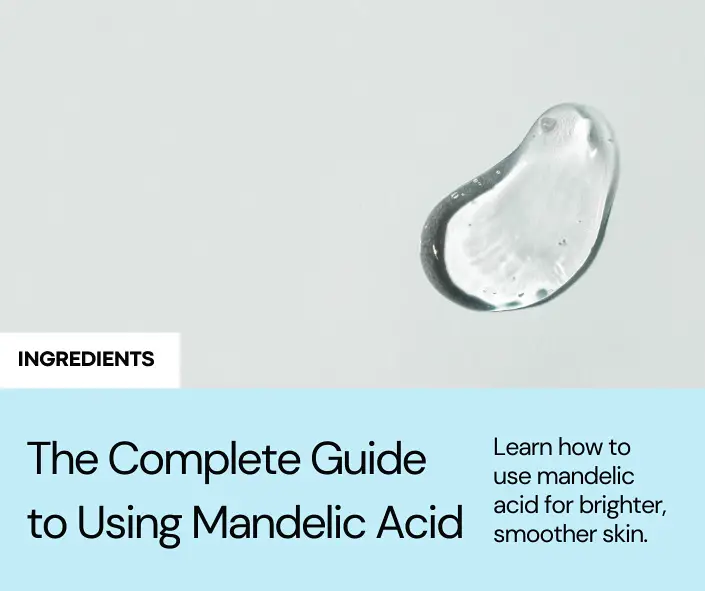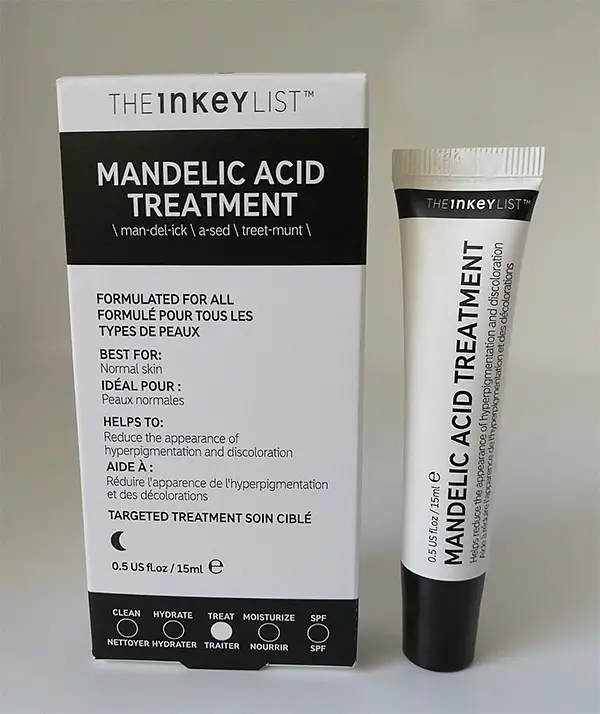
Mandelic acid has been gaining popularity in recent years for its numerous benefits for the skin. It is a gentle exfoliant that can help with acne, fine lines, and uneven skin tone. If you’re wondering how often to use mandelic acid or if it’s safe to use every day, you’ve come to the right place. In this article, we will provide you with a complete guide on how to use mandelic acid, including its benefits, uses, and FAQs.
Table of Contents
- What is Mandelic Acid?
- Benefits of Mandelic Acid
- Understanding the Different Types of Mandelic Acid Products
- How to choose the right mandelic acid product for you
- Step-by-Step Guide to Preparing Your Skin for Mandelic Acid Treatment
- How to Use Mandelic Acid Properly
- Common Mistakes to Avoid When Using Mandelic Acid
- Can mandelic acid be used on sensitive skin?
- Can mandelic acid be used with other AHAs?
- Can mandelic acid be used under the eyes?
- What happens if you use too much mandelic acid?
- Can I put moisturiser on top of mandelic acid?
- How long does it take for mandelic acid to work?
- Can I use mandelic acid and niacinamide together?
What is Mandelic Acid?
Mandelic acid is a gentle AHA that is derived from bitter almonds. It has larger molecules than other AHAs, making it a gentler exfoliant. It can penetrate the skin’s surface to exfoliate dead skin cells, improve skin texture and tone, and reduce the appearance of fine lines and wrinkles.
Benefits of Mandelic Acid
Mandelic acid has several benefits for the skin, including:
1. Acne Treatment
Mandelic acid can help treat acne by exfoliating dead skin cells, unclogging pores, and reducing inflammation. It also has antibacterial properties that can help fight acne-causing bacteria.
2. Anti-Aging Properties
Mandelic acid can help reduce the appearance of fine lines, wrinkles, and sun damage. It can also stimulate collagen production, which can improve skin elasticity and firmness.
3. Exfoliating and Brightening Effect
Mandelic acid can help even out skin tone and improve the appearance of hyperpigmentation, including dark spots and acne scars. This acid helps loosen the bonds between dead skin cells helping them shed fast to reveal smoother and brighter skin.
4. Gentle on Sensitive Skin
The larger molecular structure of mandelic acid means it penetrates the skin more slowly and gently, making it less likely to cause irritation, especially on sensitive skin
5. Antioxidant Properties
Mandelic acid has antioxidant properties that help protect the skin from free radical damage, which can contribute to premature aging.
Understanding the Different Types of Mandelic Acid Products
Here are the different types of products mandelic acid is usually formulated in and how to use them on your skin:
1. Cleansers
Mandelic acid is often included in exfoliating cleansers. These cleansers help to remove dead skin cells and impurities from the skin’s surface, leaving it feeling smooth and refreshed. They are suitable for all skin types, and even for sensitive skin. However, because mandelic acid is an exfoliant, mandelic acid-based cleansers should not be used use every day to cleanse the skin.
2. Toners
Mandelic acid toners can be used after cleansing (with a gentle cleanser) to exfoliate and brighten the skin. They can also help prep the skin for other skincare products. Mandelic acid toners are great for every skin type, especially for oily and acne-prone skin.
3. Serums
Mandelic acid serums are highly concentrated formulas that are designed to be applied after cleansing and toning the skin. They are often used to target specific skin concerns, such as acne, hyperpigmentation, and aging. These serums can be effective in improving the overall texture and appearance of the skin.
Mandelic acid serums are more potent and can penetrate deeper into the skin. They should be used at most 3x a week after cleansing, and other water-based serums. Then follow up with a moisturizer.

4. Chemical Peels
Mandelic acid chemical peels are highly concentrated treatments done by skincare professionals to treat acne, improve skin texture and tone, and reduce the appearance of fine lines and wrinkles. These treatments vary in strength ranging from 20% to 40%
Regular use of mandelic acid peels can provide a deeper exfoliation of the skin, resulting in a brighter and more youthful complexion. A treatment plan is often determined by a professional based on each individual’s needs.
5. Spot Treatments
Mandelic acid spot treatments can be used to target specific areas of concern, such as acne spots or hyperpigmentation. Mandelic acid spot treatments are usually meant to be applied solely to the affected areas. Always refer to the usage instructions from your doctor or on the product label.
6. Masks
Mandelic acid masks are designed to be applied once or twice a week to help deeply cleanse and exfoliate the skin. They can help to unclog pores, remove dead skin cells, and leave the skin feeling soft and refreshed.
7. Creams
Mandelic acid creams are moisturizing formulas that are infused with mandelic acid. They are often used to hydrate and nourish the skin while providing gentle exfoliation. These creams can be a good option for those with dry or sensitive skin.
| Product Type | Usage | Suitable For |
|---|---|---|
| Cleansers | Used to remove dead skin cells and impurities, leaving skin smooth and refreshed. | All skin types, especially sensitive skin. |
| Toners | Applied after cleansing to exfoliate and brighten the skin, and prep for other products. | Best for oily and acne-prone skin. |
| Serums | Highly concentrated, used post-cleansing and toning for targeting specific concerns like acne. | All skin types, especially for targeting specific concerns. |
| Chemical Peels | Professional treatments for deeper exfoliation, improving texture and reducing fine lines. | Severe acne, hyperpigmentation, and skin dullness (Professional use recommended). |
| Spot Treatments | Targeted application on specific areas like acne spots or hyperpigmentation. | Spot-specific areas requiring intensive care. |
| Masks | Applied 1-2 times a week for deep cleansing and exfoliation, unclogging pores. | All skin types, especially for a deep cleansing regimen. |
| Creams | Moisturizing formulas with mandelic acid, providing gentle exfoliation and hydration. | Dry or sensitive skin types. |
How to choose the right mandelic acid product for you
Choosing the right mandelic acid product for you starts by knowing if mandelic acid is the best exfoliant for your skin.
Mandelic acid is one of the mildest AHAs due to its larger molecular structure. What this means is that it doesn’t absorb as fast as stronger AHAs like glycolic acid, thus less likely to irritate the skin. This makes mandelic acid the best choice for sensitive and mature skin types.
When it comes to the type of product it all boils down to your skin’s needs and personal preference.
- Mandelic cleansers and face masks are great to help unclogs pores, especially when dealing with white or blackheads. However, because cleansers are rinse-off products you might not get the best out of a mandelic acid-based cleanser.
- Serums, toners, and spot treatments made with mandelic acid are usually of higher concentration. These are also leave-on products and are more suitable to treat acne and hyperpigmentation.
- Mandelic acid chemical peels are best for more in-depth treatment. This is ideal for people dealing with severe forms of acne, hyperpigmentation, and skin dullness.
Step-by-Step Guide to Preparing Your Skin for Mandelic Acid Treatment
To prepare your skin for mandelic acid treatment, follow these simple steps:
1. Stop using Retinoids or other acids
Two weeks before starting mandelic acid treatment, stop using any retinoids or other acids, such as salicylic or glycolic acid. These products can sensitize the skin, making it more prone to irritation.
2. Do a Patch Test
Perform a patch test to check for any allergic reactions or sensitivity to mandelic acid. Apply a small amount of the product on your inner forearm and wait for 24 hours to see if any redness, itching, or irritation occurs.
3. Hydrate your Skin
Make sure to set up a hydrating routine to prepare your skin for mandelic acid treatment. This means using hydrating serums or a hydrating moisturizer before and after your treatment. This will help prevent the skin from drying out and becoming more sensitive.
4. Protect your Skin from the Sun
Wear broad-spectrum sunscreen with an SPF of 30 or higher to protect your skin from the harmful effects of the sun. Mandelic acid treatment can make the skin more sensitive to the sun, so it’s crucial to protect your skin.
How to Use Mandelic Acid Properly
Exfoliants need to be used with care in other to avoid all risks of irritation. Here’s how to use your mandelic acid-based products safely:
How to apply mandelic acid
Depending on the type of product, mandelic acid can be applied both on wet or dry skin. In the case of cleansers and toners and moisturizers apply them on damp skin. However, in the case of a serum apply it to dry skin to allow this oil-soluble molecule to be properly absorbed.
How often should you use mandelic acid?
How often you should use mandelic acid depends on your skin type and sensitivity. In general, it is recommended to use mandelic acid-based products no more than 2-3 times a week to avoid over-exfoliating and damaging your skin’s natural barrier. Over-exfoliation can lead to dryness, irritation, and even breakouts, so it’s important to start slowly and gradually increase the frequency if your skin tolerates it well.
When is it best to use mandelic acid?
For optimal results, it’s best to use mandelic acid at night. This is because mandelic acid is an alpha-hydroxy acid (AHA) that can increase skin sensitivity to sunlight, which can lead to sun damage. Therefore, using mandelic acid at night can help reduce the risk of skin irritation and sunburn.
Precautions and Safety Measures
It’s important to start with a low concentration of mandelic acid and gradually increase it over time to avoid irritation. Do not forget to do a patch test before applying mandelic acid to your face. Always follow the instructions on the product and consult with a skincare professional if you have any concerns.
Common Mistakes to Avoid When Using Mandelic Acid
- Overusing mandelic acid – Over-exfoliation can cause irritation, redness, and breakouts. It’s important to follow the instructions on the product and start with a low concentration of mandelic acid to avoid overdoing it.
- Using other AHAs – Unless formulated together in the same product, it is not advisable to mix several exfoliants in the same routine. This will lead to over-exfoliation and skin irritation.
- Using retinol with mandelic acid – Retinol and its derivatives should be avoided at least 3-5 days before using mandelic acid as they can cause increased sensitivity to the skin.
- Not patch testing – Before using any new skincare product, including mandelic acid, it’s important to patch test it on a small area of skin first to check for any adverse reactions.
- Using too high a concentration – It’s important to start with a low concentration of mandelic acid and gradually increase it if necessary. Using too high a concentration can cause irritation and redness.
- Not moisturizing enough – Mandelic acid can be drying, so it’s important to use a good moisturizer after applying it.
- Applying mandelic acid too often – It’s recommended to use mandelic acid 1-3 times a week, depending on your skin type and the concentration of the product.
Can mandelic acid be used on sensitive skin?
Many people with sensitive skin can safely use mandelic acid. Unlike some other alpha-hydroxy acids (AHAs), mandelic acid has a larger molecular size, which means it penetrates the skin more slowly and is less likely to cause irritation.
However, everyone’s skin is different, so it’s important to start with a low concentration and patch test before incorporating mandelic acid into your skincare routine. If you experience any redness, itching, or burning, discontinue use and consult with a dermatologist.
Can mandelic acid be used with other AHAs?
Combining mandelic acid with other alpha-hydroxy acids (AHAs) can be effective in improving skin texture and tone, but it’s important to start slowly and with caution. Using multiple AHAs at the same time can increase the risk of skin irritation and sensitivity. It’s recommended to start with a low concentration of mandelic acid and gradually introduce other AHAs into your routine, such as glycolic acid or lactic acid, one at a time. Be sure to monitor your skin’s reaction and discontinue the use of any product that causes redness, itching, or burning.
Can mandelic acid be used under the eyes?
It is not recommended to use mandelic acid under the eyes. The skin in this area is delicate and sensitive, and using strong active ingredients like mandelic acid can cause irritation, redness, and dryness. Instead, opt for gentler products specifically formulated for the delicate skin around the eyes, such as eye creams or serums that contain hydrating and nourishing ingredients like hyaluronic acid, vitamin C, or peptides.
What happens if you use too much mandelic acid?
Overusing mandelic acid will cause irritation and can result in burns, redness, itchiness, bumps, or rashes.
Can I put moisturiser on top of mandelic acid?
When using mandelic acid, it’s important to follow up with a moisturizer to keep your skin hydrated and prevent dryness. Mandelic acid, like all alpha-hydroxy acids (AHAs), can be drying and may strip the skin of its natural oils. Applying a moisturizer after using mandelic acid can help restore moisture and keep your skin healthy and balanced.
Look for a lightweight, non-comedogenic moisturizer that won’t clog your pores, and avoid using heavy creams or oils that could potentially worsen acne or congestion.
How long does it take for mandelic acid to work?
The length of time it takes for mandelic acid to work depends on the specific skin concern you are treating. For mild acne, you may see results in as little as 1-2 weeks, while more severe forms of acne may take up to 4 weeks to improve. For hyperpigmentation, it can take up to 4-6 weeks to see significant changes in skin tone and texture.
However, everyone’s skin is different, and results may vary. It’s important to use mandelic acid consistently as part of your skincare routine and be patient as it works to improve your skin’s appearance and texture.
Can I use mandelic acid and niacinamide together?
Mandelic acid and niacinamide can be used together to address multiple skin concerns, including acne, hyperpigmentation, and uneven texture. Niacinamide is a water-soluble ingredient that is compatible with mandelic acid, which is oil-soluble. It’s recommended to apply niacinamide first, as it has a lightweight texture and can easily penetrate the skin.
Wait a few minutes for the niacinamide to absorb before applying mandelic acid-based products to ensure optimal effectiveness. Always be cautious when combining active ingredients and start with a low concentration of each to avoid irritation or sensitivity.
Related articles:
Mandelic Acid vs Azelaic Acid: Which One Should You Choose?
How to Use Mandelic and Hyaluronic Acid in Your Routine
Mandelic acid vs Glycolic acid
Can I use mandelic acid and alpha-arbutin together?
Mandelic Acid and Vitamin C Comparison

Petra Nakashian (previously Kravos) is a dedicated natural health and beauty blogger, driven by the loss of her parents to cancer, which led her to meticulously research beauty product ingredients. With over 10 years of experience, her in-depth knowledge has made her a trusted expert in the field. Founder of Be Healthy Now and Green Beauty Talk, Petra recently expanded her expertise with Beauty Insights Hub, exploring a wider range of beauty treatments. Committed to transparency and honesty, her work is a vital resource for navigating the complex world of beauty.

